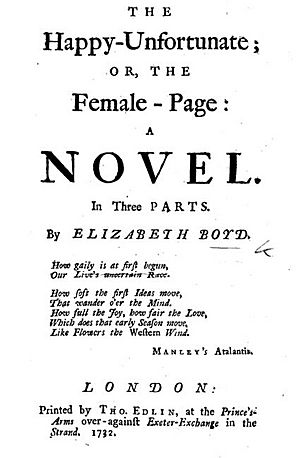Elizabeth Boyd facts for kids
Elizabeth Boyd (around 1710 – 1745) was an English writer and poet. She wrote many novels, poems, a play, and even a magazine to support her family. She also used pen names like Louisa or Eloisa. Elizabeth Boyd was one of only three known members of the Shakespeare Ladies Club.
Contents
Life of a Writer
Not much is known about Elizabeth Boyd's early life or how she started her career. We know from her writings that she came from a large family. Her family had supported the Stuart royal family, who were no longer on the throne. She began writing to help her sick mother and her family. Many important people bought her books, showing her family used to be well-known, even though they were struggling financially.
Early Writings
Elizabeth Boyd first published poetry using the name Louisa. Her early works included Variety: A Poem (1727) and Verses on the King's Birthday (1730).
Popular Novels
Her first big book was a novel called The Happy Unfortunate; Or The female page. It came out in 1732 and was printed again in 1737. This story is a "masquerade romance." In it, the main female characters hide who they really are for most of the book. With the money she earned from this novel, she opened a stationery shop in London.
Poetry and Plays
In 1733, she published The Humorous Miscellany. This collection included her most famous poem, On the Death of an Infant of five Days old. Elizabeth also wrote a play called Don Sancho, Or The Students Whim (1739). This play was never performed on stage. However, it was read aloud in the green room of the Theatre Royal, Drury Lane.
Shakespeare's Influence
Don Sancho takes place in an Oxford College garden. It even features the ghosts of famous writers William Shakespeare and John Dryden. At the end of the play, a goddess named Minerva creates a monument to Shakespeare. Because of this ending, many experts believe Boyd was part of the Shakespeare Ladies Club. This club worked to raise money for a statue of Shakespeare. This statue is now in Poet's Corner in Westminster Abbey.
Later Works
In 1745, Elizabeth Boyd started an ambitious project called The Snail: Or the Lady's Lucubrations. This was meant to be a regular magazine for important ladies. Only one volume was published. Her writings from this time suggest that her health was getting worse. The magazine included hidden criticisms of the Duke and Duchess of Marlborough. They had once supported the Stuart family but later changed their minds.


